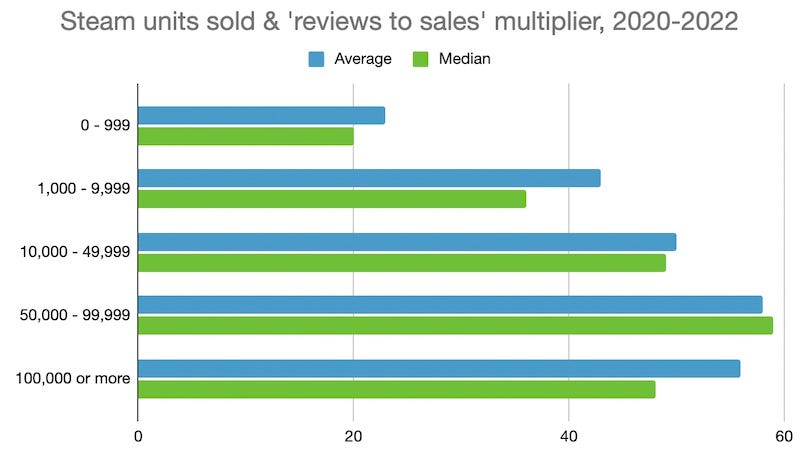Probably the most popular way to estimate game sales on Steam is to add a certain multiplier to their review count. The problem is that the median ratio for big new releases has gone way up over time, so it is time to make some adjustments.

Simon Carless revisited this topic in the latest GameDiscoverCo newsletter. The report, which estimates average and median review/sales ratios for 2020-2022 titles, shows that the median multiplier for hot new games has gone from 30x to almost 60x over time.
The results are based on an anonymous survey of 200 Steam games, with sales ranging from 20 units to 16.8 million units.
- Usually, the fewer copies a game sells on Steam, the lower its review multiplier. For example, titles with less than 1,000 units sold have a median multiplier of 20x.
- The ratio is going up from this point, reaching 59x for 50,000-99,000 copies sold. However, it slightly decreases to 48x for games with over 100,000 units.

Image credit: GameDiscoverCo
- As Carless explained, Steam users are much more willing to leave reviews for niche games (small developers ask their friends to support their title, players want to recommend it to others, etc.).
- The more sales a game generates, the more casual players it attracts. Carless has already pointed out that this audience tends to write shorter reviews, with many of these gamers just playing games and leaving no reviews at all. So that’s why the ratio is usually higher for Steam’s biggest hits.
Side note 1: of course, there are exceptions to this rule. For example, Elden Ring, which recently hit 17.5 million units sold across all platforms, has over 400,000 reviews on Steam. “It’s likely this is because Elden Ring is a ‘game that people want to talk about’ — with >90% Positive reviews,” Carless noted. “And so 1 in 20-25 players leave a review, compared to the 1 in 50-60 that is more normal with a large-scale game.”
- It is also worth noting that Early Access titles typically have 20-30% less reviews per one unit sold than “full” games. So it would be fair to add 25% to the median multiplier in this case.
- Another important thing to consider is that the median multiplier for all games released in 2022 is still around 30x. The overall trend shows that review ratios have gradually gone down over time, from over 75x in 2016 to 29x in 2022.
Side note 2: “All estimates can and should be taken with a grain of salt,” Carless noted. So yes, the “review-to-sale multiplier” method is far from perfect, but it can still be helpful to see the whole picture and make some estimations for yourself.
More details and fancy data can be found in the full report. Carless also shared a link to the survey results (the answers are anonymous, but it is still pretty interesting info to look at and perhaps draw your own conclusions).
